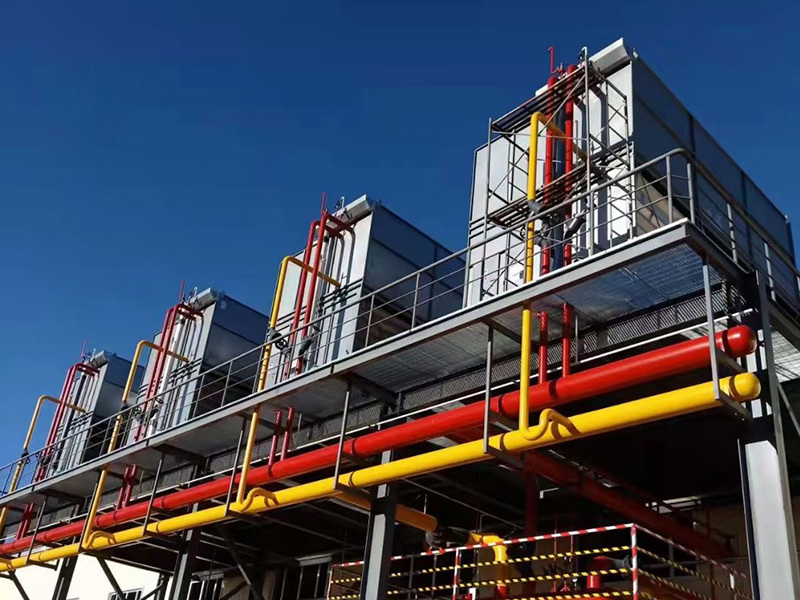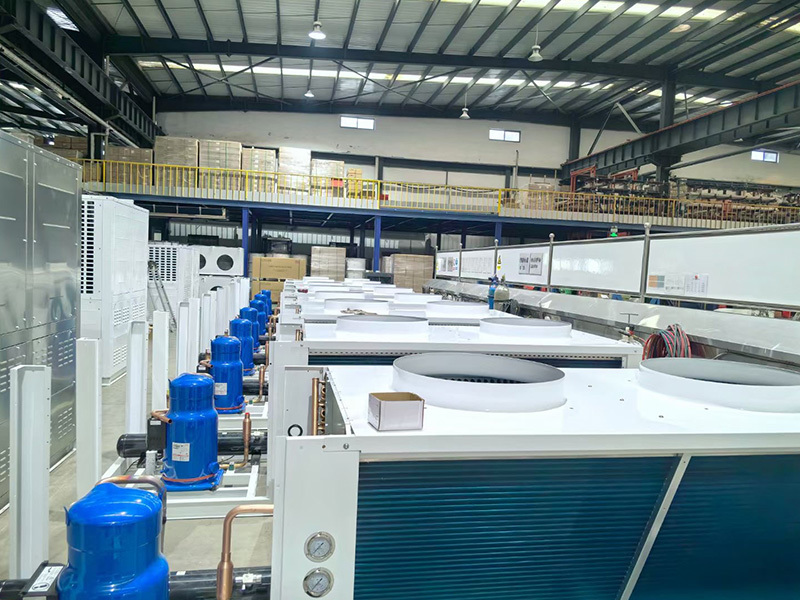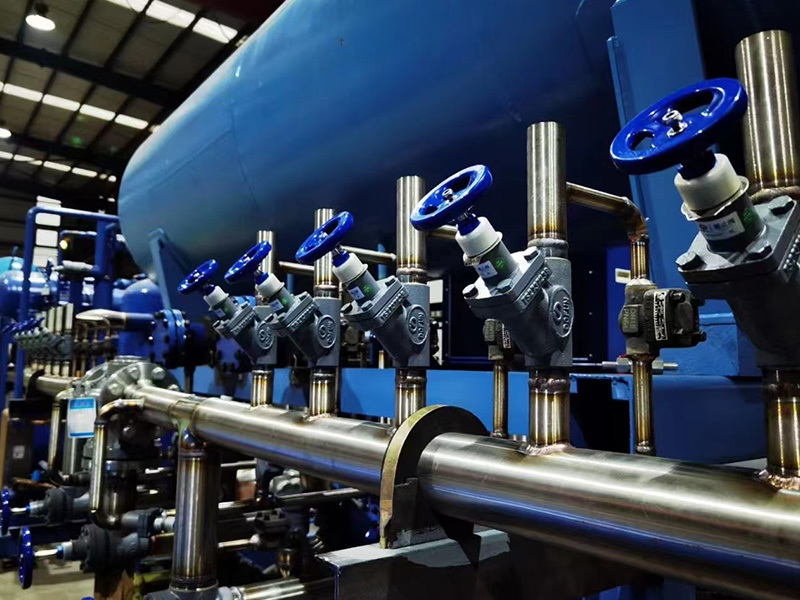There are five main reasons why the cold storage compressor exhaust is overheated
Release time:
Jul 23,2024
The main reasons for the exhaust gas temperature overheating are as follows: high return air temperature, large motor heating, high compression ratio, high condensing pressure, and improper refrigerant selection.
The main reasons for the exhaust gas temperature overheating are as follows: high return air temperature, large motor heating, high compression ratio, high condensing pressure, and improper refrigerant selection.
(1) High return air temperature
The return air temperature is relative to the evaporation temperature. In order to prevent liquid return, the return air pipeline generally requires a return air superheat of 20°C. If the return air pipeline is not well insulated, the superheat will far exceed 20°C.
The higher the return air temperature, the higher the cylinder suction temperature and exhaust temperature. For every 1°C increase in return air temperature, the exhaust temperature will increase by 1 to 1.3°C.
(2) Motor heating
For return air cooling compressors, the refrigerant vapor is heated by the motor when flowing through the motor cavity, and the cylinder suction temperature is increased again. The heat generated by the motor is affected by power and efficiency, and the power consumption is closely related to displacement, volumetric efficiency, working conditions, friction resistance, etc.
For return air cooling semi-hermetic compressors, the temperature rise range of the refrigerant in the motor cavity is roughly between 15 and 45°C. In air-cooled (air-cooled) compressors, the refrigeration system does not pass through the winding, so there is no problem of motor heating.
(3) Compression ratio is too high
The exhaust temperature is greatly affected by the compression ratio. The larger the compression ratio, the higher the exhaust temperature. Reducing the compression ratio can significantly reduce the exhaust temperature. Specific methods include increasing the suction pressure and reducing the exhaust pressure.
The suction pressure is determined by the evaporation pressure and the resistance of the suction pipe. Increasing the evaporation temperature can effectively increase the suction pressure and quickly reduce the compression ratio, thereby reducing the exhaust temperature.
Some users believe that the lower the evaporation temperature, the faster the cooling speed. This idea actually has many problems. Although lowering the evaporation temperature can increase the freezing temperature difference, the cooling capacity of the compressor is reduced, so the freezing speed is not necessarily faster. Moreover, the lower the evaporation temperature, the lower the refrigeration coefficient, while the load increases, the operating time is extended, and the power consumption will increase.
Reducing the resistance of the return air pipe can also increase the return air pressure. Specific methods include timely replacing the dirty and blocked return air filter and minimizing the length of the evaporator pipe and the return air pipe. In addition, insufficient refrigerant is also a factor in low suction pressure. Refrigerant should be replenished in time after leakage. Practice shows that reducing the exhaust temperature by increasing the suction pressure is simpler and more effective than other methods.
The main reason for the high exhaust pressure is that the condensation pressure is too high. Insufficient heat dissipation area of the condenser, fouling, insufficient cooling air volume or water volume, too high cooling water or air temperature, etc. can all lead to excessive condensation pressure. It is very important to select a suitable condensation area and maintain sufficient cooling medium flow.
The high temperature and air conditioning compressors are designed to operate with a relatively low compression ratio. After being used for refrigeration, the compression ratio increases exponentially, the exhaust temperature is very high, and the cooling cannot keep up, causing overheating. It is necessary to avoid using the compressor beyond the range and make the compressor work at the minimum possible pressure ratio. In some low-temperature systems, overheating is the primary cause of compressor failure.
(4) Reverse expansion and gas mixing
After the suction stroke begins, the high-pressure gas retained in the cylinder clearance will undergo a reverse expansion process. After the reverse expansion, the gas pressure returns to the suction pressure, and the energy consumed for compressing this part of the gas is lost in the reverse expansion. The smaller the clearance, the smaller the power consumption caused by the reverse expansion, and the larger the suction volume, so the compressor energy efficiency ratio is greatly increased.
During the reverse expansion process, the gas absorbs heat from the high-temperature surfaces of the valve plate, the top of the piston and the top of the cylinder, so the gas temperature will not drop to the suction temperature at the end of the reverse expansion.
After the reverse expansion is over, the real suction process begins. After the gas enters the cylinder, it mixes with the reverse expansion gas and the temperature rises; on the other hand, the mixed gas absorbs heat from the wall and the temperature rises. Therefore, the gas temperature at the beginning of the compression process is higher than the suction temperature. However, since the reverse expansion process and the suction process are very short, the actual temperature rise is very limited, generally less than 5°C.
Reverse expansion is caused by the cylinder clearance, which is an unavoidable shortcoming of traditional piston compressors. If the gas in the exhaust hole of the valve plate cannot be discharged, there will be reverse expansion.
(5) Compression temperature rise and refrigerant type
Different refrigerants have different thermophysical properties, and the exhaust temperature rise after the same compression process is different. Therefore, different refrigerants should be used for different refrigeration temperatures.
Conclusion and Suggestions
The compressor should not have overheating phenomena such as high motor temperature and high exhaust temperature when operating normally within the use range. Compressor overheating is an important fault signal, indicating that there are serious problems with the refrigeration system or improper use and maintenance of the compressor.
If the root cause of compressor overheating lies in the refrigeration system, the problem can only be solved by improving the design and maintenance of the refrigeration system. Replacing a new compressor cannot fundamentally eliminate the overheating problem.
NEWS
How to troubleshoot the freezing problem of the chiller evaporator?
Insufficient refrigerant. The chiller may leak or seep refrigerant due to long installation or use time. When the refrigerant in the refrigeration system is reduced, the evaporation pressure is too low, resulting in ice on the evaporator. The location of the ice is generally in the front part of the evaporator. The troubleshooting method is to first deal with the leaking part and add enough refrigerant, and the fault will be eliminated.
How to solve the problem of low cooling capacity and high power consumption of the unit
After long-term use, the condenser is prone to scale formation in the pipes. If it is not handled in time, these scales will affect the heat exchange effect, causing the condensation temperature of the unit to increase, which in turn leads to a decrease in cooling capacity and an increase in unit power consumption. Therefore, the condenser should be descaled frequently.
There are five main reasons why the cold storage compressor exhaust is overheated
The main reasons for the exhaust gas temperature overheating are as follows: high return air temperature, large motor heating, high compression ratio, high condensing pressure, and improper refrigerant selection.

What should we pay attention to when designing cold chain logistics?
What should be paid attention to in the design of cold chain logistics? Cold chain logistics is an important way for us to transport food. The emergence of cold chain logistics has made our food no longer seasonal. What should be paid attention to in the design of cold chain logistics?

Causes of overheating of refrigeration compressor exhaust
The main reasons for the overheating of the exhaust gas temperature in the refrigeration system are as follows: high return air temperature, large motor heating, high compression ratio, high condensing pressure, and improper refrigerant selection.





